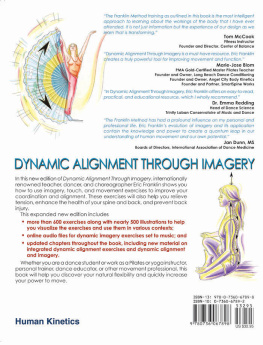Illustrated by Sonja Burger and Eric N. Franklin
2016 Eric Franklin
All Rights Reserved.
No part of this publication may be reproduced, stored in a retrieval system, or transmitted, in any form or by any means, electronic, mechanical, photocopying, recording, or otherwise, without the written permission of the author.
First published by Dog Ear Publishing
4011 Vincennes Rd
Indianapolis, IN 46268
www.dogearpublishing.net
ISBN: 978-1-4575-4706-5
This book is printed on acid-free paper.
Printed in the United States of America
Contents
For my kids:
Nalini, Roshan, Savita, Ondine
Introduction
T here are many excellent books on the anatomy and physiology of cells. This is the first book, however, devoted entirely to using mental imagery to improve the health of your cells, with emphasis on firsthand experience and practice. This book features the Franklin Method. What makes the Franklin Method unique is the specific effect of the power of thinking and dynamic physiological imagery on your physical state. Over the past 25 years, I have written many books on mental imagery, but here, for the first time, we will take it down a scale, to the cells of your body: the basic building blocks of your being.
The Franklin Method approach can be applied to any movement to improve its function. My goal is to create happy minds and healthy bodies using Dynamic Neurocognitive Imagery (DNI) .
Dynamic Neurocognitive Imagery (DNI) combines knowledge and research from a variety of fields including anatomy, kinesiology, biomechanics, and neuroscience. Using the DNI approach, we have developed tools and approaches for imagery use, which are being implemented nowadays in many universities, dance academies and sports organizations around the world.
The DNI research team is constantly working on investigating various aspects of the beneficial effects of DNI on human motor performance; this team is composed of specialists in the fields of imagery, biomechanics, and motor performance.
The correlation of health and imagery has been studied for years by the largest research centers worldwide, such as the National Institutes of Health in the United States. The power of imagery has shown successful application in sport, dance, and exercise (see Franklin, 2014 and Franklin, 2014). Todays athletes excel through their sophisticated use of mental imagery and related mental skills.
Founded by Eric Franklin in 1994, the Franklin Method makes use of movement, dynamic imagery, anatomical and physiological embodiment, and educational skills to create lasting positive change in your body and mind. The Franklin Method is taught all over the world, including the University of Vienna in Austria, the universities in Cologne and Karlsruhe in Germany, the Juilliard School, and New York University. The Franklin Method is recognized by health providers in Switzerland and is regularly presented at dance, Pilates, yoga, and physiotherapy conferences throughout the world.
CHAPTER 1
The Power of Imagery
O ne of the greatest discoveries of the 21st century is that the lives we live shape the brains we develop, referred to as the plasticity of the brain. The Franklin Method is at the forefront of practical neuroplasticity, showing you how to use your brain to improve your bodys function. Starting with the knowledge that we have the power to change, the Franklin Method teaches you how to harness the transforming power of the mind to move your body with maximum efficiency and keep your body youthful and energized. A special focus of the Franklin Method is learning how it can be applied to improve all of your abilities.
If you want to change your body, start by changing your mind. (Eric Franklin)
Research has shown that the most effective way to create changes in your brain is to change your thinking. Such mental interventions influence your immune system and organs in a positive way. These tools are free and always available to you, and have only beneficial side effects, so lets learn how to use them well.
Thinking, mental imagery, and physicality interact. We become what we imagine, and our imagination reflects our physical state. It is a two-way street. As your body represents the images and words present in your head, your mind will adapt to your posture, movement coordination, and tension level. A hurdler who is trained in mental imagery can visualize jumping the hurdles quickly and elegantly, making it to the finish line victoriously. A long-distance runner employs imagery to produce a sensation of flow, the feeling of running without trying. Thus, the running experience becomes a meditation, a prayer to the bodys cells, so to speak. Science has repeatedly shown how imagery is a successful athletes number-one mental skill (Feltz and Landers, 1983; Murphy, Nordin, and Cumming, 2008; Richardson, 1967b).
Negative imagery is powerful, too! While trained use of positive mental imagery goes hand-in-hand with achievement-oriented thoughts and actions, a body that is slouched and of low tone will accompany slouched and low-tone thoughts. Many people muse about their excess weight, sagging skin, weak muscles, wrinkles, or hair loss. They seem to be unaware of the fact that through such negative mental training, they are creating exactly what they dont want. This effect depends on the amount and strength of the negative thinking; it isnt about prohibiting negative thoughts dogmatically. If we only matter-of-factly become aware of our lack of abdominal tone and decide to do something about it, there will be no counterproductive effect. If, however, we decide to continuously obsess about our flabbiness but dont do anything about it, the negative imagery will assist in the bodys adaptation to these thoughts, with the result of increased flabbiness. This mental display serves as a transmitting station to the cells.
Some people may consider negative thoughts to be motivating. For example, a fear of being unattractive can result in a person starting to go to the gym, albeit with apprehension and fear rather than enjoyment. Fear strongly encourages negative mental training, however. When one is terrified, one distinctly visualizes things one doesnt want to happen. The basis of effective mental training consists of a clear positive image, physical sensation, and emotional fortification. All of these are present during fear as well as rage, but in a very negative way. If one were to use the same elements to create positive images with positive emotions attached to them, the results would be very pleasing. Although visualizing the skin cells as clear, free, firm, and flexible may be a challenge at the outset, with time, you can learn how to use imagery with conviction and physical percipience. Everything takes practice; imagery is no different: Your skill will increase with the number of times you practice.
What Is Embodiment?
Imagerys role in your physical well-being occurs through your experience of embodiment. Embodiment is a physical insight that may be experienced as an improved sense of the enjoyment that accompanies a moving body. Referred to as a kinesthetic image, such an image is not just visual but is also felt in the body. It is a sensed knowing (a physical aha!) rather than an intellectual understanding. It is as if the body is communicating with you directly and telling you about its best function. A mental insight, rather than a physical one, may be a precursor to having an embodiment and may arouse the curiosity necessary to arrive at an embodiment, but it is not an embodiment. Embodiments can be likened to very clear images, often visual and kinesthetic. Once you experience the physical sensations evoked by the imagery, you realize that your previous knowledge about the benefits of the image was merely intellectual.












